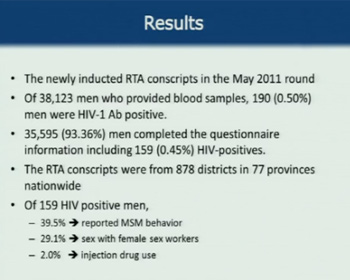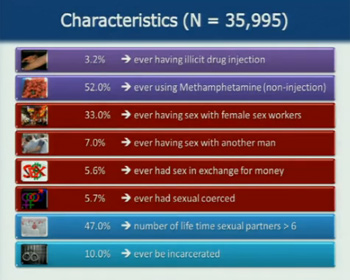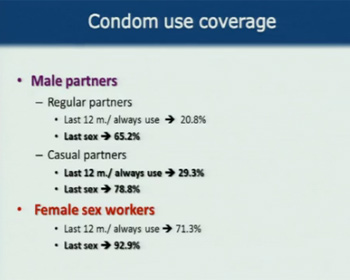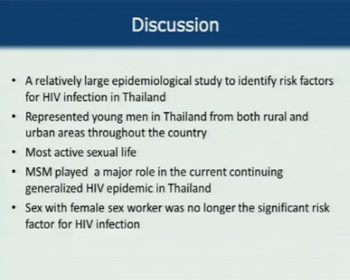A large, randomised sample of 21-year-old Thai men, presented at the 19th International AIDS Conference in Washington recently, has found that by far the largest risk factor for HIV infection is gay identity. Contrary to the oft-quoted saying “it’s not who you are, but what you do,” actual male/male sexual behaviour, while still an important risk factor, was not as strongly associated with being HIV positive as gay identity.

The survey was conducted among over 35,000 army conscripts from all parts of Thailand. All 21-year old Thai men enter a lottery at the age of 21 for conscription into the Thai army and of these half a million young men, 60,00 to 100,000, in any year, are conscripted, twice a year in May and October.
This survey thus constituted a truly randomised, cross-sectional survey of the 21-year-old men who were inducted into the Thai army in May 2011. It was conducted no more than two weeks after induction and therefore serving in the army had no influence on the results. Men from all provinces in Thailand were included and from both urban and rural areas.
The survey found that 7% of respondents had had sex with another man (MSM) but that only 1.1% only had sex with men.
In all MSM, 83% identified as heterosexual, i.e. desiring women only. Even in exclusive MSM, only 21% said they desired men exclusively and 31% both men and women, meaning that nearly half (48%) of men who’d in fact only ever had male partners said they actually preferred women.
Only 0.5% of all respondents had HIV, and only 2.6% of the MSM. However HIV prevalence increased to 9.4% in men who exclusively had sex with men, and to 16% in men who said they preferred sex with men, i.e. who identified as gay or transgender. Gay identity was in fact quite uncommon, at 180 individuals out of 35,359, or 0.5% of respondents.


Having sex with both men and women was associated with a 4.5-fold higher risk of having HIV, and solely having sex with men with a 35-fold raised risk; but defining oneself as wanting sex with men and women was associated with a 26-fold raised risk, and as wanting sex only with men with an over 60-fold raised risk.
One of the explanations for desire being a greater risk factor than behaviour was that sex role was highly predictive of HIV infection: compared with exclusive ‘tops’, ‘versatile’ gay men were 6.8 times more likely to have HIV and exclusive ‘bottoms’ 8.6 times more likely. If non-gay-identified MSM are more likely to be insertive, this would explain why activity was less predictive of HIV than identity.
Another might be that the culturally-accepted way of being an MSM in Thailand, at least outside urban centres with gay scenes, has tended to be to become a Katoey (ladyboy/transgender). 'Out' Kaoteys would tend to be exempted from military service, until 2011 because they had a 'mental disorder', now changed to 'gender identity disorder'. So this survey would tend to under-represent certain self-identified MSM.
Other traditional HIV risk factors were more common than MSM sex. While only 3.2% of all respondents had ever injected drugs, 33% had had sex with a female sex worker, 10% had been in prison and no less than 52% had ever used non-injectable methamphetamine which, as Yaa Baa (‘mad pills’), is the most common recreational drug in the country.
Other risk factors associated with HIV included having a lot or a little education, compared with the average: being a graduate was associated with a nearly two-fold raised risk of HIV and having less than 10 years’ education with a 1.7-fold raised risk. Other unsurprising risk factors were having been paid for sex (5.6% of respondents had, and 2% of those had HIV), ever having had forced sex, and having had more than six lifetime sex partners (the median number), which doubled the HIV risk.
Other risk factors were all heightened in men who’d had sex with men (except injection drug use, which was no more common). Of all MSM, 19% had been jailed, 16% had ever had forced sex, 31% had sold sex for money, and no less than 69% had used methamphetamines. Perhaps surprisingly, even the proportion who had had sex with female sex workers was higher than in the whole sample – 52%.


Slides are obtained from the webcast viewable at aids2012.org
However, far from their being risk factors for HIV infection, in the whole group, having had sex with a female sex worker and injection drug use were actually associated with a reduced risk of HIV infection. These associations were not statistically significant, but in the group of men who had sex with men, sex with female sex workers and imprisonment were also associated with a lower likelihood of HIV infection, and these associations were significant.
The researchers found that condom use with female sex workers (FSWs) was very high – 93% of the men used one last time they had contact with an FSW and 71% every time in the last 12 months. The same was true of female casual partners – 79% had used a condom with one last time, though only 29% all the time in the last year. But when it came to sex with men, condom use was less common, with 65% using one last time and 21% consistently in the last year.
The findings of this survey differ from previous surveys of gay men in selected Thai cities, which have found very high rates of HIV prevalence (30% in Bangkok) and incidence (over 6%).
This shows the difference between surveying a self-selecting gay/MSM population – the Bangkok surveys have been conducted in gay clubs, STI clinics and cruising areas – and looking at sexuality and HIV prevalence in a truly random sample of men.
The most interesting findings were that MSM behaviour and gay sexuality or desire were so loosely associated with each other, and that the risk factors traditionally associated with HIV in Thailand appear no longer to be risk factors.
Reference
Rangsin R et al. The recent impact of MSM on the prevalence of HIV-1 among young men in Thailand. Nineteenth International AIDS Conference, Washington DC. Abstract THAC0303. 2012. See abstract here.
This article was first published by NAM/Aidsmap.com and is republished with permission.
The recent impact of MSM on the prevalence of HIV-1 infection
among young men in Thailand (Time: 17 mins)
Speaker: Professor Ram Rangsin, author of the study and
an epidemiologist attached to the Royal Thai Army
